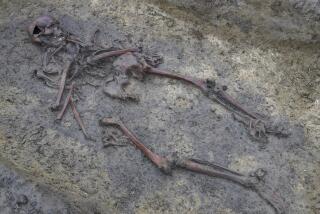Caribbean burial ground may shed light on slaves
CHARLOTTE AMALIE, U.S. VIRGIN ISLANDS — CHARLOTTE AMALIE, U.S. VIRGIN ISLAND -- A paper trail documents their lives as human property, from their passage across the Atlantic to their sale as slaves for sugar plantations. Now a newly discovered burial ground promises to shed light on the lives and deaths of Africans in the Caribbean.
Researchers from Denmark and the U.S. Virgin Islands want to unearth as many as 50 skeletons next year in hopes of learning about their diet, illnesses and causes of death, and thus broaden knowledge of slave life in the onetime Danish colony.
Descendants of slaves could discover ancestors through DNA tests. At public meetings, islanders also have embraced the excavations as a way for Europeans to recognize their historic role in the slave trade -- and perhaps to make amends.
Most slaves in the Americas were buried in unmarked graves, and studies of slave graveyards “are rarer than hen’s teeth. The science that will come out of it will just be extraordinary,” said David Brewer, an archeologist with the U.S. Virgin Islands government and one of the scientists planning to unearth some tombs this month to assess their condition before the project starts in March.
The slaves are buried in shallow graves beneath mounds of stones and conch shells, some marked by small, illegible headstones. They were found this year on a private 300-acre estate on St. Croix, the largest island.
Details have been withheld while researchers negotiate access to the property, said Brewer, who would not identify the owner or the exact location of the graveyard.
The scientists will examine teeth and bones and conduct chemical analysis in a mobile laboratory. Brewer said the bones would be disturbed as little as possible and reburied exactly as they were found.
One fingernail-sized shaving will be taken from each skeleton for a database of African DNA that could reveal links to other slave populations.
“This is the closest we can possibly get to telling the story of their lives as they knew it,” said Pia Bennike, an anthropologist leading the team from the University of Copenhagen.
More than 100,000 enslaved Africans, mostly from what is now Ghana, arrived in the Danish West Indies from 1617 to 1807, according to Myron Jackson, director of the U.S. Virgin Islands’ historical preservation office. Many were sold and shipped to the American colonies, while thousands remained as the property of Danish colonists.
From the time they were big enough to work, slaves cut sugar cane and picked crops in the heat, Jackson said. When severe drought hit in 1725 and 1733, some plantation owners starved their workforce rather than pay for food to be shipped in.
David Brion Davis, a Yale University historian, said that Caribbean slaves died much faster than those on the mainland and had a lower birthrate.
“Sugar production was a very, very taxing -- almost lethal -- kind of occupation,” he said, noting that many lost limbs in machines.
Slaves who plotted revolt, tried to escape or threatened a white man were punished by 150 lashes, brandings on their forehead, or having a leg or ear chopped off. Others were hanged or tortured to death.
The Danes outlawed slavery in 1848. The United States bought the three-island territory from Denmark in 1917.
No demands for reparations from Denmark have been made. But educating Europeans about their role in the slave trade could lead to more Danish investment and possible payments, said Shelley Moorhead, president of the African-Caribbean Reparations and Resettlement Alliance, based in St. Croix.
Davis said he was particularly interested in whether the genetic testing would show how often blacks and whites interbred.
More to Read
Sign up for Essential California
The most important California stories and recommendations in your inbox every morning.
You may occasionally receive promotional content from the Los Angeles Times.










